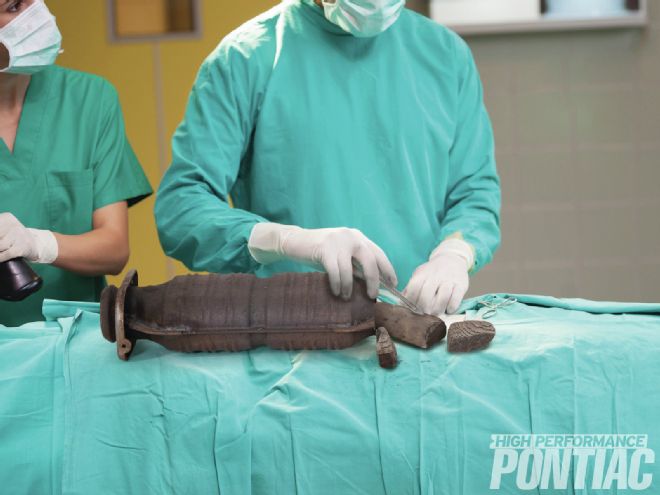
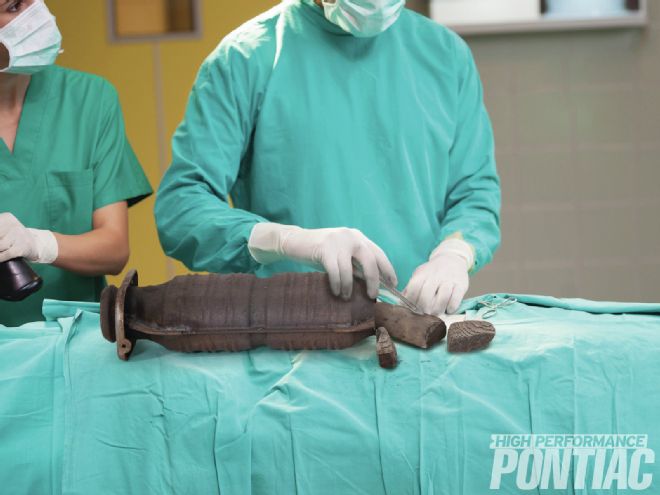
Last month in “Crying Fouled,” we showed how the factory catalytic converter in our ’95 Firebird Firehawk was robbing us of driveability. It had become so contaminated from unspent fuel that its internal substrate separated from the shell, broke into huge chunks, and blocked airflow downstream through the exhaust system. It was too late for our poor catalytic converter, but hopefully there’s still time to save yours.
“The common causes of catalytic converter failure are preventable,” says Eastern Catalytic’s Emissions Certification Engineer Charlie Pantano. Eastern Catalytic is one of the nation’s largest manufacturers of aftermarket catalytic converters. It produces direct-fit replacement cats for most Pontiacs from ’75 through ’10.
“Preventative maintenance is the most important tool a car owner can use to increase the life of the catalytic converter,” Pantano says. “Engine conditions such as leaky fuel injectors and engine misfires can destroy a converter long before the Check Engine light comes on.”
So how do you prevent catalytic-converter failure? Eastern Catalytic’s engineers shared the following nine tips, which cover the three main categories of converter failure—thermal (catalytic converters are designed to work with a maximum operating temperature of 1,400 degrees F), plugged substrate, and physical damage.
Another important point to remember is that if your converter fails, be sure to have the reason properly diagnosed and the problem corrected so the new converter doesn’t meet the same fate.
1 Cat Cookout
Excessively high exhaust temperatures burned this catalytic converter to a crisp. The most likely culprit was an exhaust leak upstream in the pipes. Why? Exhaust leaks cause external unmeasured air to enter the exhaust stream, which then dilutes the air/fuel ratio. The additional oxygen causes higher-than-normal temperatures within the catalytic converter. A second suspect part is the EGR valve. If it’s faulty, higher than normal exhaust temperatures will also result, cooking the cat.
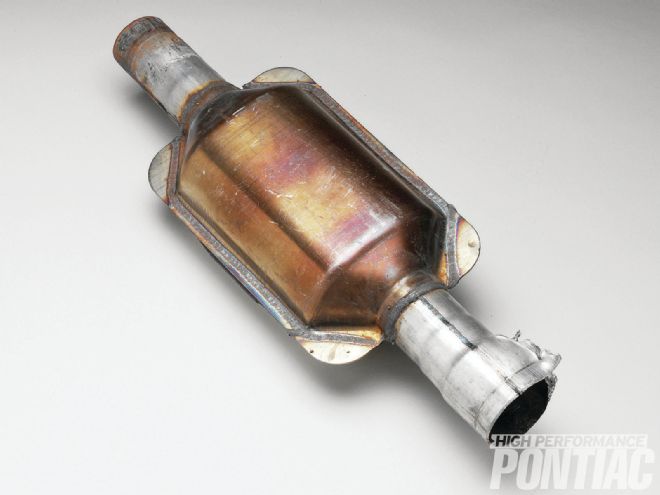
Preventative Measures: Correct your exhaust leaks and check your EGR valve for proper operation.
2 Silicone Slam Dunk
Silicone used to seal exhaust manifolds, headers, or O2 sensor threads will burn when exposed to high temperatures. When this happens, it produces a gas that coats the surface of the O2 sensor and causes incorrect oxygen readings. This is called outgassing. The ECU, in turn, will adjust tuning based upon what the O2 sensor is telling it. The coated O2 is fooled into thinking the mixture is leaner than it actually is, and the result is an overly rich condition that will raise converter temperatures.
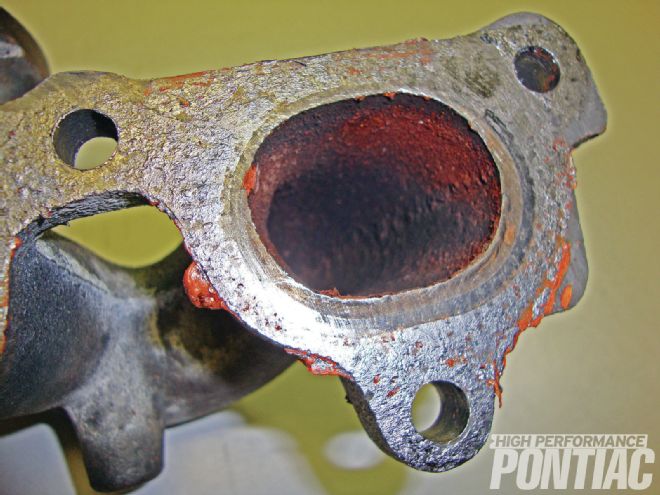
Preventative Measures: Using silicone products in lower temperature areas of the engine, such as the intake manifold, water neck, oil pan, and valley pan, is safe. However, no silicone product should ever be used on the exhaust side of the engine.
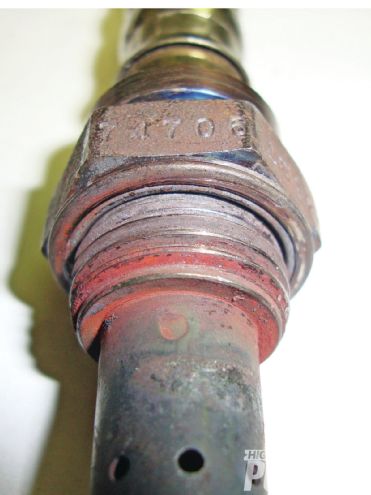
3 The Terror of Teflon
Like silicone, Teflon also produces outgassing when it burns, and contaminates the O2 sensors. The O2 sensors rely on a metal-ring gasket similar to a spark-plug gasket for sealing. You would never put Teflon on a spark plug, and it does not belong on an O2 sensor.
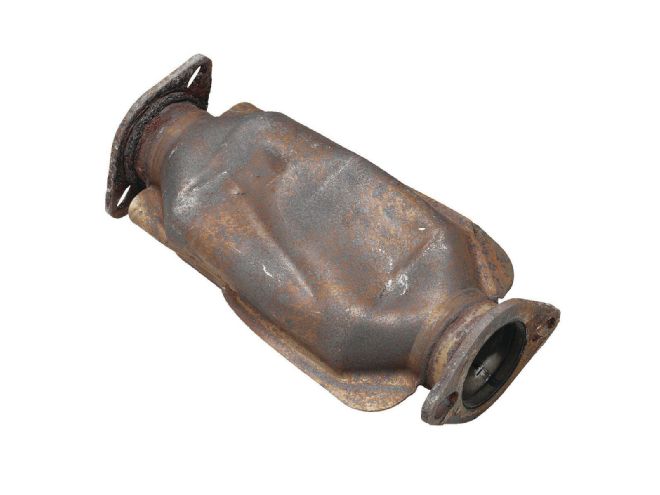
Preventative Measures: A small amount of antiseize is acceptable to use on O2 threads.
4 Help Me, I’m Melting
Overheating your engine can do more than shorten its lifespan—look what it did to a catalytic converter. Running your engine at substantially higher than normal coolant temps can induce misfires and detonation, which can melt the ceramic substrate inside the converter and cause its matting to fail.
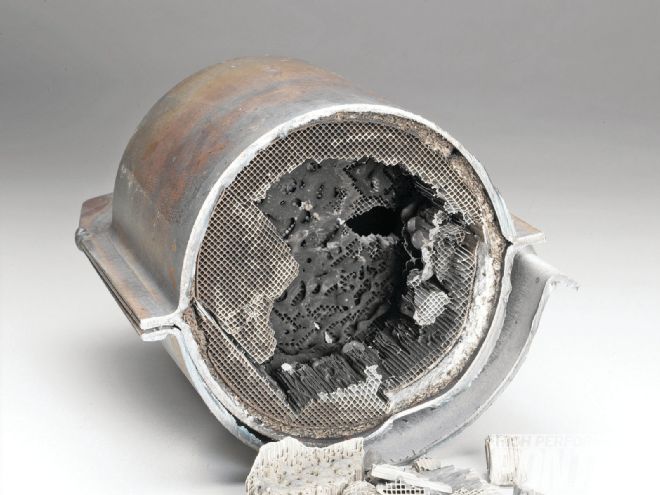
Preventative Measures: Don’t fall into the trap of thinking your engine just happens to run a lot hotter than others like it. There is a cooling issue that needs correction. If you ignore it, your cat—if not your head gaskets or engine—will probably pay the price.
5 That’s Not Incense You’re Burning
Blue smoke from your tailpipes may be the first visual clue that your piston rings, valve seals, or valve guides are allowing oil to burn inside of your engine. To get to those tailpipes, the oil has to pass through the catalytic converter. Oil-fouling of the cat, like the one shown here, can be prevented by making sure the aforementioned parts are in good working condition.
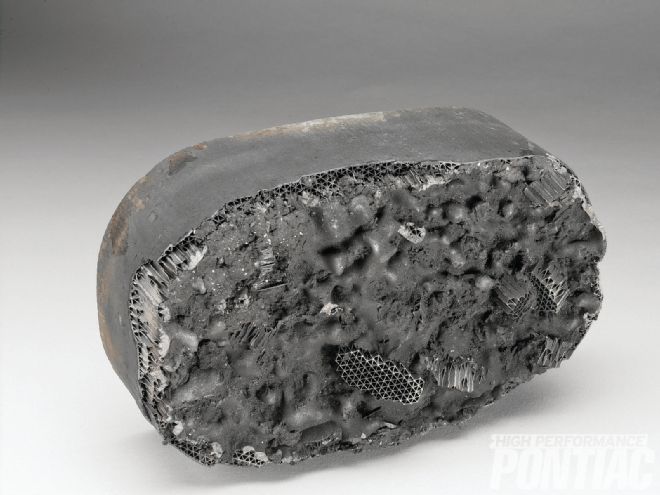
Preventative Measures: Proper engine maintenance including regular oil changes using a quality name brand oil of the correct viscosity is the first step. If you fear there is engine wear causing oil to enter the combustion chambers, a compression test and/or leakdown test can be performed as a diagnostic measure.
6 It’s Getting Hard to Breathe
Often caused by incomplete combustion, a plugged cat will rob you of power and fuel economy. The culprit is often leaky fuel injectors or high fuel pressure, as both conditions can cause raw, unspent fuel to escape the combustion chamber, flow downstream, and ignite upon contact with the converter. The result is black soot, which is guaranteed to clog your converter and shorten its life. Late-model Firebird owners with LT1s have even more reason to fear incomplete combustion, as a failed Optispark will not ignite the fuel provided by the injectors. Raw fuel entering the combustion chambers will create high hydrocarbons and damage the cat quickly.
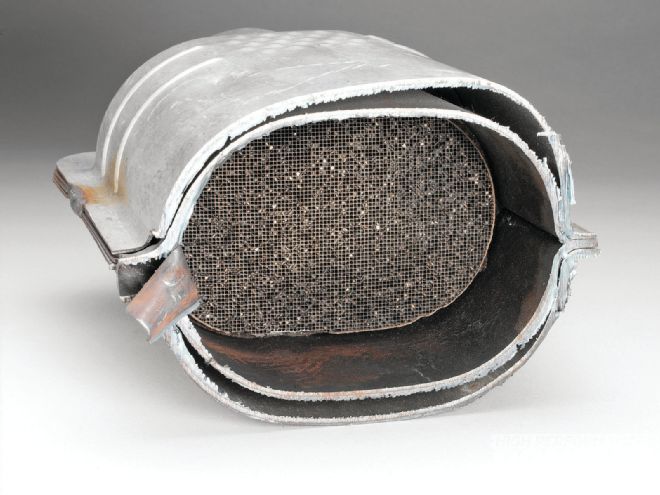
Preventative Measures: Inspect your fuel injectors regularly for signs of leaking, and replace if necessary. Check your fuel pressure. If it’s high, make sure your regulator is operating correctly or replace it. If you have a failed Optispark, don’t even crank the engine until you’ve installed a new Optispark.
7 Thar She Blows
Commonly caused by a blown head gasket, a cracked head, or a blown intake-manifold gasket, an antifreeze leak into the combustion chambers is dangerous to your catalytic converter. Why? The antifreeze will exit through the exhaust manifolds, travel downstream, and coat the surface of the substrate. The result will be inefficiency because the converter will no longer scrub the exhaust, and the car may not pass emissions testing.
Preventative Measures: Coolant in the oil making it look like a milkshake is a sign of an intake manifold gasket leak, a head gasket failure, or a cracked head. White smoke from the tailpipes is another. Proper engine maintenance will help avoid these situations.
8 Carbon-Based Life Forms
Have you ever taken your Pontiac in for service and been sold on the idea of a carbon cleaner? This popular “up sell” promises to remove the carbon from your combustion chambers and cylinders. The danger is waiting until your Pontiac has high mileage before performing the service, as large pieces of carbon (0.030-inch or more) will clog the converter when they dislodge from your engine.

Preventative Measures: Have the procedure performed at regular internals. (“Every two years or 30,000 miles,” says Autoway Chevrolet Service Advisor Chris Sullo.)
9 Bumps, Humps, and Clumps
Catalytic-converter casings, like this one shown here, are not impervious to road hazards. If debris crushes your casing, the substrate brick may separate, and clog your airflow downstream. Dead skunks in the middle of the road aren’t the only hazards to look out for. Speed bumps, especially if you have low-hanging exhaust, can also be a threat to the casing.
Preventative Measures: Steer around road debris instead of shouting, “That’s 10 points,” and giving your passenger-buddy a high-five when you purposefully run over it. Examine your low-hanging exhaust. More than likely, a hanger has come loose, and it’s a quick fix to reconnect it. Even taking your vehicle to a muffler shop to weld a failed muffler bracket is a nominal cost, compared to a cat replacement.
How to Break in Your Cat
A replacement catalytic converter needs to undergo a proper break-in procedure to ensure that it will continue to work as it should, and deliver the required emissions reliability and long service life. If the converter is not warmed-up properly (broken-in), the substrate inside could be adversely affected and eventually cause the converter to fail prematurely.
A problem typically occurs when a shop installs the converter and immediately returns the vehicle to the customer without breaking in the cat. The customer drives away and runs the car for a long distance or lets the vehicle idle for an extended period of time. Under these conditions, the matting, which is intended to secure the substrate, will not expand properly and hold it in place.
Converter matting is made from a mineral called vermiculite, which is held together by a fiber mat and an organic binder. This matting is wrapped around the converter’s ceramic brick. The matting is installed in the converter in an unexpanded state. During the first heat up, the fiber mat and binder burn off, and the matting actually gets looser before it expands to fill the converter cavity and hold the ceramic brick in place. If that warm-up is not done properly, the brick can come loose and get damaged. That rattle you might hear inside the converter shell is a sure telltale sign of this problem.
Warm Up That Cat First
The best way to avoid this service issue and potential warranty problems is to include the warm-up period as a key part of your overall converter installation procedure. This heating cycle will allow for correct matting expansion.
Here are suggested steps for a proper break-in or warm-up: